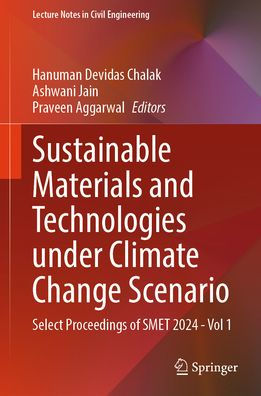Sustainable Materials and Technologies under Climate Change Scenario: Select Proceedings of SMET 2024 - Vol 1
This book encompasses economic, social, and environmental dimensions, aiming for a balance that ensures the well-being of both people and the planet over the long term. Sustainability and environmental protection are crucial topics in today's world. Sustainability refers to the ability to meet the needs of the present without compromising the ability of future generations to meet their own needs. Addressing these issues requires collaboration, innovation, and a commitment to change at all levels of society. By prioritizing sustainability and environmental protection, we can work toward a healthier, more equitable, and more resilient future for all. Sustainability of a system is its ability to survive and retain its functionality over time. For an engineered system to be sustainable, it should be efficient, reliable, resilient, and adaptive. Thus, the objective of sustainable engineering is to ensure the integration of an engineered system into the natural and man-made environment without compromising the functionality of either the engineered system or that of the ecosystem and society, and this harmony between the natural and built environments must be maintained at the local, regional and global scales. Therefore, in the engineering domain, sustainability can be looked upon as a dynamic equilibrium between four E’s—engineering design, economy, environment, and equity. As climate change and resource scarcity continue to pose major challenges, there is an urgent need for more sustainable solutions in construction industry. In response to these challenges, the construction industry is actively exploring and implementing more sustainable practices and materials. This shift aims to reduce the environmental impact of material production, extend the service life of structures, and minimize resource consumption. Researchers, industry professionals, and policymakers are collaborating to develop and promote innovative technologies, materials, and strategies that can significantly reduce the carbon footprint, energy use, and waste generation associated with construction.
1147152433
Sustainable Materials and Technologies under Climate Change Scenario: Select Proceedings of SMET 2024 - Vol 1
This book encompasses economic, social, and environmental dimensions, aiming for a balance that ensures the well-being of both people and the planet over the long term. Sustainability and environmental protection are crucial topics in today's world. Sustainability refers to the ability to meet the needs of the present without compromising the ability of future generations to meet their own needs. Addressing these issues requires collaboration, innovation, and a commitment to change at all levels of society. By prioritizing sustainability and environmental protection, we can work toward a healthier, more equitable, and more resilient future for all. Sustainability of a system is its ability to survive and retain its functionality over time. For an engineered system to be sustainable, it should be efficient, reliable, resilient, and adaptive. Thus, the objective of sustainable engineering is to ensure the integration of an engineered system into the natural and man-made environment without compromising the functionality of either the engineered system or that of the ecosystem and society, and this harmony between the natural and built environments must be maintained at the local, regional and global scales. Therefore, in the engineering domain, sustainability can be looked upon as a dynamic equilibrium between four E’s—engineering design, economy, environment, and equity. As climate change and resource scarcity continue to pose major challenges, there is an urgent need for more sustainable solutions in construction industry. In response to these challenges, the construction industry is actively exploring and implementing more sustainable practices and materials. This shift aims to reduce the environmental impact of material production, extend the service life of structures, and minimize resource consumption. Researchers, industry professionals, and policymakers are collaborating to develop and promote innovative technologies, materials, and strategies that can significantly reduce the carbon footprint, energy use, and waste generation associated with construction.
219.99
Pre Order
5
1

Sustainable Materials and Technologies under Climate Change Scenario: Select Proceedings of SMET 2024 - Vol 1
579
Sustainable Materials and Technologies under Climate Change Scenario: Select Proceedings of SMET 2024 - Vol 1
579Hardcover
$219.99
219.99
Pre Order

Product Details
| ISBN-13: | 9789819658978 |
|---|---|
| Publisher: | Springer Nature Singapore |
| Publication date: | 02/16/2026 |
| Series: | Lecture Notes in Civil Engineering , #631 |
| Pages: | 579 |
| Product dimensions: | 6.10(w) x 9.25(h) x (d) |
About the Author
From the B&N Reads Blog
